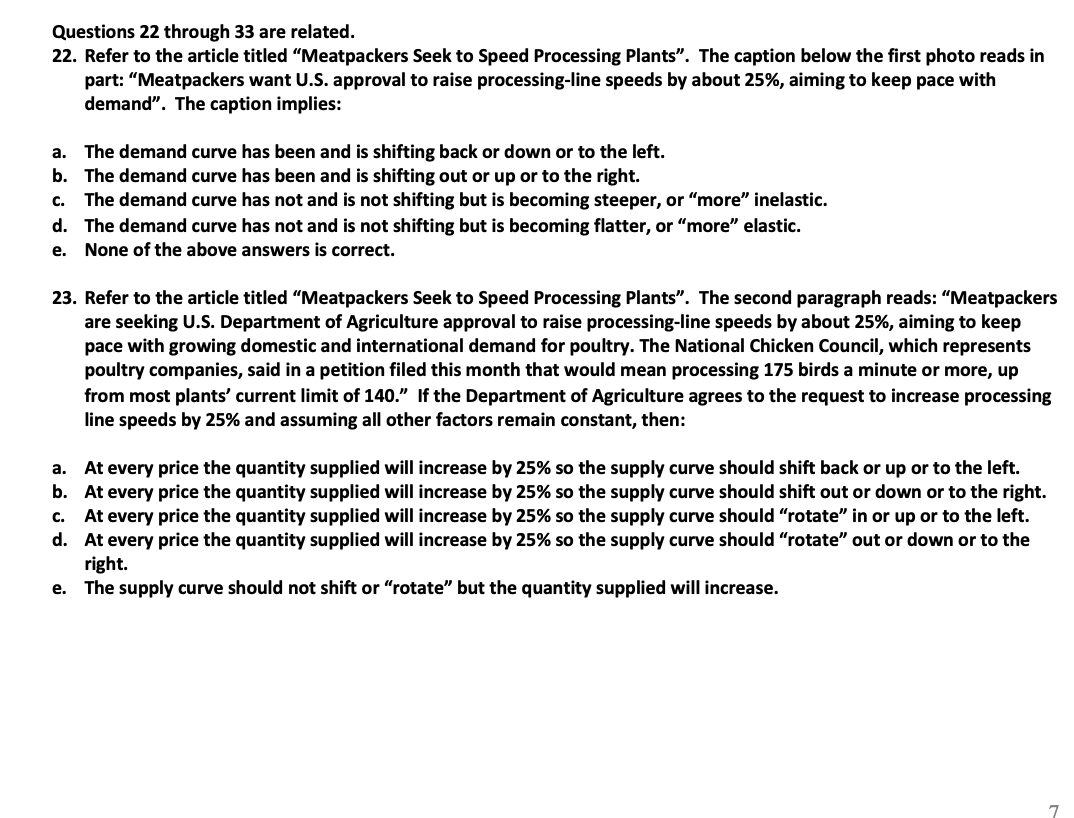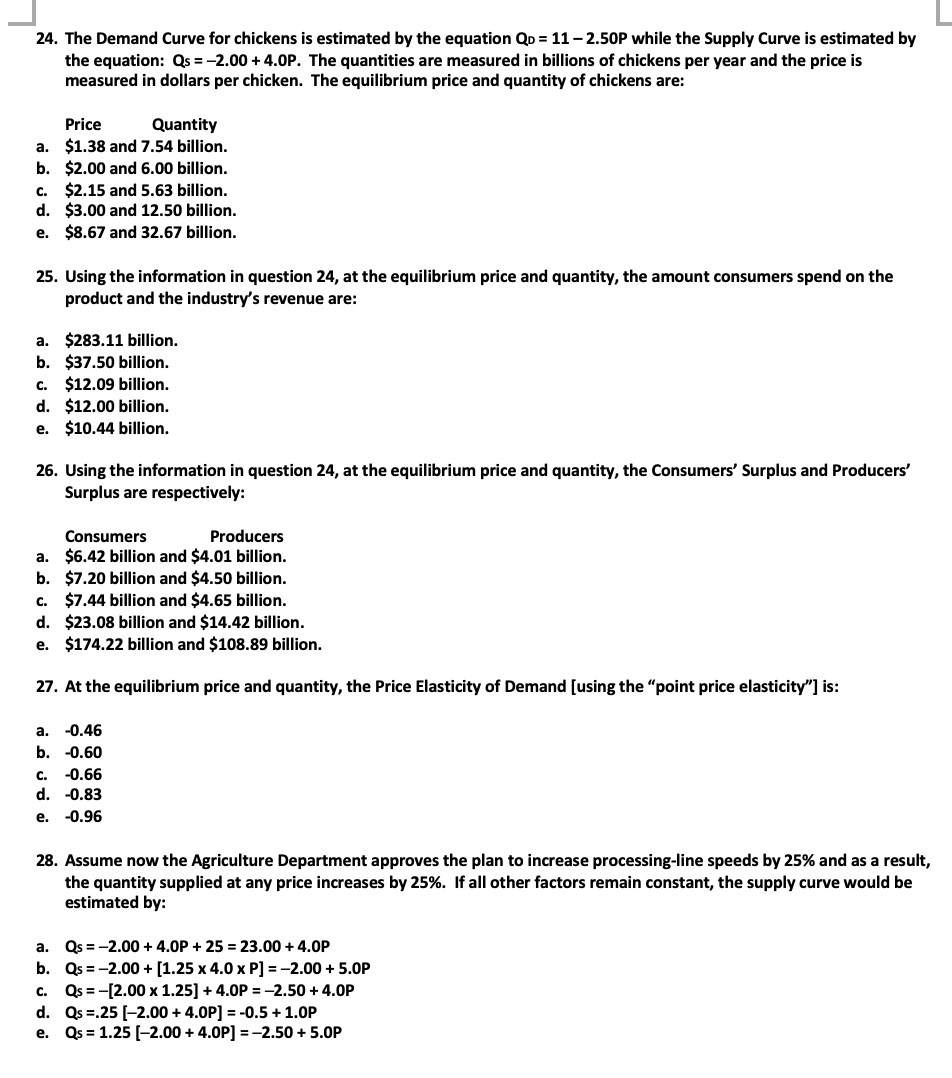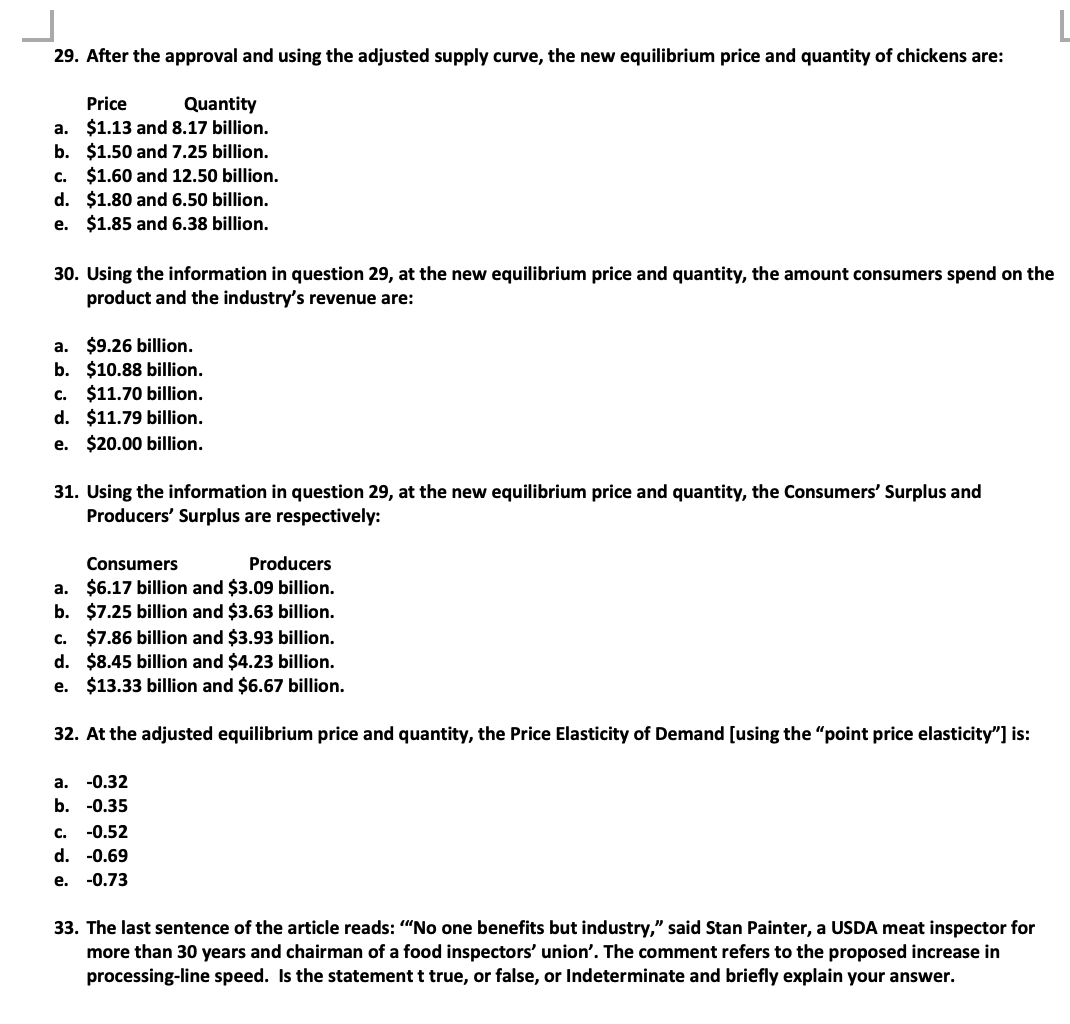Please EXPLAIN NUMBER 33 THOROUGHLY SO I CAN UNDERSTAND.
Questions 22 through 33 are related. 22. P-F'P' Refer to the article titled "Meatpackers Seek to Speed Processing Plants\". The caption below the first photo reads in part: "Meatpackers want U.S. approval to raise processing-line speeds by about 25%, aiming to keep pace with demand\". The caption implies: The demand curve has been and is shifting back or down or to the left. The demand curve has been and is shifting out or up or to the right. The demand curve has not and is not shifting but is becoming steeper, or "more\" inelastic. The demand curve has not and is not shifting but is becoming atter, or "more\" elastic. None of the above answers is correct. Refer to the article titled "Meatpackers Seek to Speed Processing Plants\". The second paragraph reads: "Meatpackers are seeking U.S. Department of Agriculture approval to raise processing-line speeds by about 25%, aiming to keep pace with growing domestic and international demand for poultry. The National Chicken Council, which represents poultry companies, said in a petition filed this month that would mean processing 175 birds a minute or more, up from most plants' current limit of 140.\" If the Department of Agriculture agrees to the request to increase processing line speeds by 25% and assuming all other factors remain constant, then: At every price the quantity supplied will increase by 25% so the supply curve should shift back or up or to the left. At every price the quantity supplied will increase by 25% so the supply curve should shift out or down or to the right. At every price the quantity supplied will increase by 25% so the supply curve should \"rotate\" in or up or to the left. At every price the quantity supplied will increase by 25% so the supply curve should \"rotate\" out or down or to the right. The supply curve should not shift or \"rotate\" but the quantity supplied will increase. _| 24. The Demand Curve for chickens is estimated bythe equation (10 = 11 2.50P while the Supply Curve is estimated by 99999 l3 99999 3-1 99999 99999 99999 the equation: as = -2.00 + 4.0P. The quantities are measured in billions of chickens per year and the price is measured in dollars per chicken. The equilibrium price and quantity of chickens are: Price Quantity $1.38 and 7.54 billion. $2.00 and 6.00 billion. $2.15 and 5.63 billion. $3.00 and 12.50 billion. $8.67 and 32.67 billion. . Using the information in question 24, at the equilibrium price and quantity, the amount consumers spend on the product and the industry's revenue are: $283.11 billion. $37.50 billion. $12.09 billion. $12.00 billion. $10.44 billion. . Using the information in question 24, at the equilibrium price and quantity, the Consumers' Surplus and Producers' Surplus are respectively: Consumers Producers $6.42 billion and $4.01 billion. $7.20 billion and $4.50 billion. $7.44 billion and $4.65 billion. $23.08 billion and $14.42 billion. $174.22 billion and $108.89 billion. . At the equilibrium price and quantity, the Price Elasticity of Demand [using the \"point price elasticity"] is: 0.46 0.60 0.66 0.83 0.96 . Assume now the Agriculture Department approves the plan to increase processing-line speeds by 25% and as a result, the quantity supplied at any price increases by 25%. If all other factors remain constant, the supply cunre would be estimated by: as = 2.00 + 4.09 + 25 = 23.00 + 4.09 0.5: 2.00 + [1.25 x 4.0 x 9] = 2.00 + 5.09 q. = [2.00 x 125] + 4.09 = 2.50 + 4.09 o. =.25 [2.00 + 4.09] = -0.5 + 1.09 o; = 1.25 [2.00 + 4.09] = 2.50 + 5.09 _| 29. PEI-PF.\" {S 999?. PEI-PF.\" After the approval and using the adjusted supply curve, the new equilibrium price and quantity of chickens are: Price Quantity $1.13 and 8.17 billion. $1.50 and 7.25 billion. $1.60 and 12.50 billion. $1.80 and 6.50 billion. $1.85 and 6.38 billion. Using the information in question 29, at the new equilibrium price and quantity, the amount consumers spend on the product and the industry's revenue are: $9.26 billion. $10.88 billion. $11.70 billion. $11.79 billion. $20.00 billion. . Using the information in question 29, at the new equilibrium price and quantity, the Consumers' Surplus and Producers' Surplus are respectively: Consumers Producers $6.17 billion and $3.09 billion. $7.25 billion and $3.63 billion. $7.86 billion and $3.93 billion. $8.45 billion and $4.23 billion. $13.33 billion and $6.67 billion. 32. At the adjusted equilibrium price and quantity, the Price Elasticity of Demand [using the \"point price elasticity"] is: PEI-PF.\" 43.32 -O.35 -O.52 43.69 43.73 33. The last sentence of the article reads: "'No one benefits but industry,\" said Stan Painter, a USDA meat inspector for more than 30 years and chairman of a food inspectors' union'. The comment refers to the proposed increase in processing-line speed. Is the statement t true, or false, or Indeterminate and briey explain your









